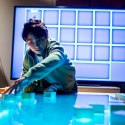Undergraduate Symposium is a mix of new and old traditions
Since 1999, undergraduates have been given the chance to showcase their original research and achievements through the Undergraduate Symposium. Honoring the work of talented students, the symposium offers a chance for campus and the greater community to see students’ research, art exhibits and performances.
The symposium features presentations in a variety of media, such as talks, roundtable sessions, live performances, posters, art and project displays. The symposium will be held on Tuesday, April 12 from 9 a.m. to 4:15 p.m. in the Great Hall of Memorial Union.
The newest additions to the symposium this year are roundtable discussions. Though they are new to this event, they are a popular presentation format at other professional conferences. By having presenters and attendees sit together, they will be able to maximize their interaction and engage in thoughtful discussion.
Additionally, to include the Year of the Arts, the symposium will have 26 art projects in the theater gallery in Memorial Union. There will be a gallery talk at 3:30 p.m. on Tuesday, April 12.
As the symposium has changed since its inception, it has become quite popular on campus. This year there will be approximately 560 students presenting, whereas in 2006 there were about 215.
This year’s symposium program will also include announcements of upcoming related undergraduate showcase events such as the Digital Salon, Engineering Expo, and la moda processa: 2011 Design Gallery and TASA Fashion Show.
“Participating in research and presenting work is often a life-changing experience for undergraduates,” says Laurie Mayberry, assistant vice provost. “By working with a faculty or staff mentor, students learn how to work closely with others and share their product with the public,” she says.
Jess Senjem, a senior majoring in anthropology and Spanish, will be presenting a poster project titled “The Effects of Changing Culture and Religion on Burial Orientation.” Working at an archaeological site in Troy, Turkey, Senjem studied the effects of culture and religion on grave layouts. Much of her research shows basic similarities in burial practice throughout this region; what she found changed most over time were the position and orientation of the bodies buried.
“I enjoy studying human remains to determine facts about their lives when they were living,” Senjem says. “Learning about past cultures and peoples is fascinating, and I like the hands-on aspect of working with bones.”
Senjem went on to explain that much of what she discovered were things she had not known before she began her research. She sees the symposium as an opportunity to present her findings in a new way as well as the chance to verbally explain her research.
Mayberry explains this is a key advantage of undergraduate research: “It’s one thing to be able to convey knowledge to someone who understands the language of the project…it’s another to be able to teach someone about a subject in a language that they can easily understand. The experience is often priceless.”
Maichou Lor, a Ronald E. McNair scholar and senior in the School of Nursing, collaborated with colleagues in the nursing school to further understand why Hmong women would or would not seek breast or cervical cancer screening. She is presenting a poster at the symposium.
With colleagues, she interviewed numerous women in Hmong, learning that many of norms associated with their beliefs about health care were traditionally based; the women were very unfamiliar with western medical practices. “As a member of the immigrant Hmong community, I have witnessed the fear and death from untreated cancers in my community,” she says.
Motivated by her hope that health care leaders will take concrete steps to maximize the health care needs of her community, Lor wants nothing more than to promote early detection of cancers-when these may be cured more readily-and assure that the Hmong have the means to access affordable health care.
All students come to the symposium with different hopes of what will come from their research. As Lor hopes to have attention from legislators, Senjem wants to teach others about how burials have changed over time and how their culture may affect how they will be laid to rest.
Both Senjem and Lor are eagerly anticipating sharing their research with members of the community. Research is very important to their future careers, as Senjem plans to attend graduate school for paleoanthropology and Lor will continue studying nursing in the Early Entry Ph.D. Option program at UW–Madison.

